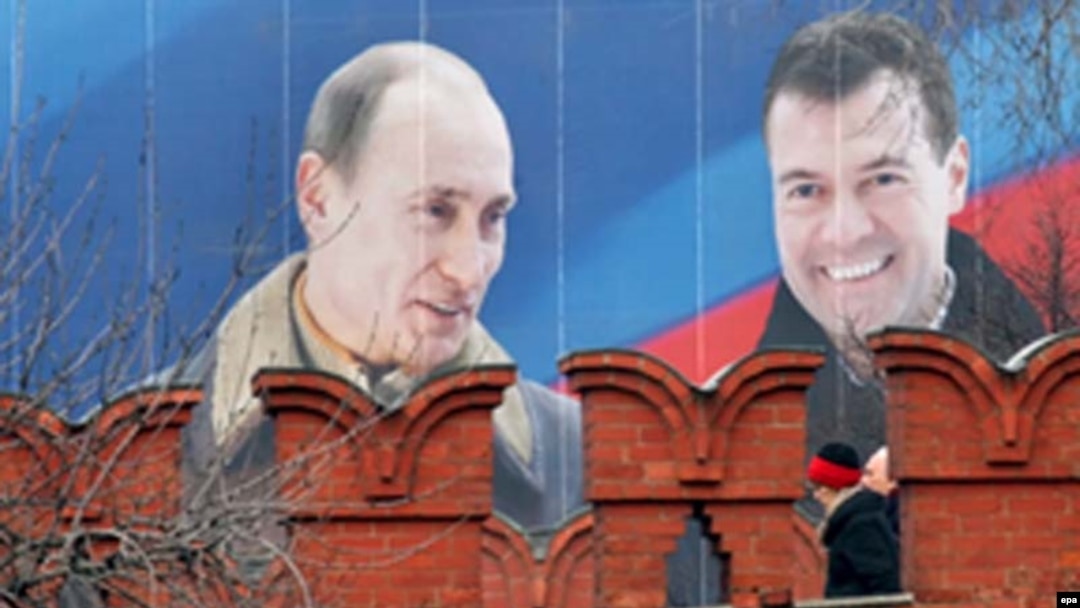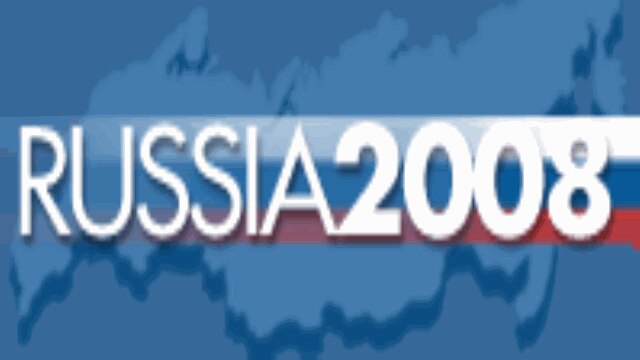But speaking at a press conference on February 14, outgoing President Vladimir Putin made it clear that he wasn't planning on bestowing such customary respect on his handpicked successor, Dmitry Medvedev.
"Of course, if I become prime minister it would be a unique situation in so far as I myself have been president for the past eight years and have not done badly," Putin told reporters. "In order to build relations with Dmitry Anatolyevich Medvedev, if he is elected president, I do not need to hang his portraits. We have enough other means to build a working relationship aimed at solving the problems of developing the country."
Russia is about to enter one of the stranger transition periods in its recent history. As Putin's anointed heir, Medvedev is widely expected to sail to election as Russia's third post-Soviet president in the March 2 vote. Putin, for his part, has said he would serve as Medvedev's prime minister.
Given this arrangement, there are two burning questions on everybody's mind: Who will really be in charge? And will this "diarchy," as some Russian pundits have dubbed it, lead to instability?
Remain In Charge
It has long been clear that the Putin-Medvedev relationship would not follow the conventional model of a subservient prime minister genuflecting before an overbearing patron-president. Medvedev, after all, is a "made man" politically only because Putin made him -- cultivating his career for more than a decade and ultimately promoting him to the highest office in the land. Moreover, Putin enjoys public esteem and adulation that Medvedev -- at least at this point -- cannot match.
Speaking to RFE/RL's Russian Service, opposition politician Vladimir Ryzhkov said Putin's recent statements, including the February 14 press conference, are intended to show the elite that he plans to remain in charge.
"This was not an appearance of an outgoing president," Ryzhkov said. "It was a speech by a leader who plans to continue being a leader. There has always been an understanding that there is a person No. 1 and a person No. 2."
But after his presumptive inauguration in May, it will be Medvedev who will have all the accoutrements of power. His office will be in the Kremlin, he will have formal control over the military and security services, and he will hold the ultimate accessory for a superpower leader -- the so-called "nuclear suitcase" that holds the trigger to Russia's arsenal of nuclear weapons.
And in a recent interview with the weekly "Itogi," Medvedev seemed to indicate that he was not planning to play the role of docile figurehead, saying Russia can only be governed by "strong presidential power" and a "firm executive vertical."
How Will Relationship Evolve?
With its centuries-long tradition of strong and overbearing rulers, Russia has historically not fared well when power was shared at the very top. With some notable exceptions, divided government has tended to lead to schisms in the country's bloated bureaucracy, backroom intrigue, vicious infighting, and often crippling political instability.
Analysts say in this case, much depends on how Putin's working relationship with Medvedev evolves over time.
"A lot is going to depend on strong wills, personal factors, personal relations, ambition, pressure from interest groups," says Andrei Ryabov, a political analyst with the Moscow Carnegie Center. "These are factors that lie beyond legally defined relationships, beyond the constitution, and beyond the law."
Medvedev has been a close protege of Putin's since both served in St. Petersburg's local government in the 1990s, and has often called the outgoing Kremlin leader a father-like figure. But recent Russian history is littered with similar friendships and political alliances that crumbled as conflicting ambitions emerged.
Soviet leader Mikhail Gorbachev and Russian President Boris Yeltsin started out as like-minded reformers in the early part of the perestroika period. But their bitter rivalry intensified over the years and hastened the fall of the Soviet Union.
Yeltsin stood shoulder-to-shoulder with his vice president, Aleksandr Rutskoi, and parliament speaker Ruslan Khasbulatov to face down the August 1991 hard-line coup. But just two years later, in October 1993, Yeltsin's power struggle with his two former allies escalated into armed conflict that ended with the shelling of parliament.
In both cases, the country's ruling elite split between two competing centers of power, making the conflict more acute -- and more dangerous.
Edward Keenan, a professor of Russian history at Harvard University in the United States, says it is a pattern that has repeated itself whenever the elite split irreconcilably -- from the turmoil of the Time of Troubles in the early 17th century, to the chaos that followed the fall of the Romanov dynasty in 1917, to the free-for-all that ensued after the Soviet breakup in the 1990s.
"When the elite begins fighting among itself, it's over. They have got to at least pretend that they are a solid phalanx," Keenan says.
Bureaucratic Schisms
Russia's new diarchy is coming into being at a time when bitter rivalries have begun to emerge among the security service veterans that make up Putin's inner circle.
The so-called "siloviki war" erupted late last year, and pits one bureaucratic clique, led by Federal Antinarcotics Service head Viktor Cherkesov, against another, led by Putin's powerful deputy chief of staff, Igor Sechin, and Federal Security Service head Nikolai Patrushev.
Sechin in particular was staunchly opposed to Medvedev becoming Putin's successor and wanted the president to circumvent the constitution and seek a third consecutive term in office.
Some analysts have speculated that Putin may use anti-Medvedev "siloviki" like Sechin, Patrushev, and Aleksandr Bastrykin, who heads the powerful Investigative Committee, to keep Medvedev in check.
"There are different forces who can control [Medvedev]: Unified Russia with its constitutional majority; Sechin, who doesn't like Medvedev, who can be named head of the presidential administration or something else; Bastrykin with the Investigative Committee," says Vladimir Pribylovsky, a Moscow-based political analyst.
Additionally, analysts say some of the relatively liberal technocrats in the ruling elite, like Finance Minister Aleksei Kudrin and Unified Energy Systems CEO Anatoly Chubais, are expected to coalesce around Medvedev.
According to Ryabov, sooner or later one faction of the bureaucracy will emerge victorious.
"What we have is not just a conflict of interests, but a conflict between visions of Russia's future and the future of Russian politics," Ryabov says. "Under the conditions of this institutional diarchy, as it has been called, it is not possible to combine these different views and policies. Somebody from the center, probably in a short period of time, must take a leading role and impose their views on the future of Russian politics."
While historians note that in most instances dual power in Russia has led to instability, there have been cases where it has worked. In the 20th century, the example cited most often is Nicholas II, Russia's last tsar, sharing power with his prime minister, Pyotr Stolypin -- who spearheaded land reforms before being assassinated in 1911.
Soviet leader Leonid Brezhnev also shared power with Aleksei Kosygin, who was chairman of the Council of Ministers.
A Romanov Precedent
But Keenan, the Harvard historian, says the best example of a shared power arrangement that worked effectively was between Mikhail I, the first tsar of the Romanov dynasty, and his father, Patriarch Filaret, in the early 17th century.
Keenan describes Filaret as "an old snaggletooth warrior from Ivan the Terrible's time" who was the real power behind Mikhail's throne.
"Mikhail Fyodorovich was 16 years old when the Romanovs and the old aristocracy reestablished itself," Keenan says. "And that seemed to have worked. Father and son worked reasonably well together. Basically, Filaret ran the country."
Mikhail ascended to the throne after a 15-year period characterized by factional infighting, famine, and foreign occupation that nearly led to the collapse of the Russian state.
Putin and others in the Russian elite have characterized Yeltsin's rule in the 1990s as akin to that period -- a modern-day Time of Troubles from which the current regime, through its centralized political control, has sought to deliver the public.
With Medvedev's frequent comments that Putin is like a father to him, Keenan says, comparisons to Filaret and Mikhail seem inevitable.
"When Putin is talking about all this business about the Time of Troubles, I find it hard to believe that he hasn't thought about himself of restoring Russia the way Filaret did," Keenan says.
Sharing Power
Peter I and Ivan V (1682-96)
When Tsar Fyodor III died in 1682, he left no children and thus no clear heir to the throne. A Boyar Duma, or council of nobles, proclaimed Fyodor's two half-brothers, 10-year-old Peter I and 15-year-old Ivan V co-Tsars. A special dual-seated throne was built for the two.
Ivan was named the senior Tsar, but was physically and mentally handicapped and unable to rule. Fyodor's sister, Sophia Alekseyevna acted as regent and ruled like an autocrat for seven years. In 1689, when he was 17, Peter decided to seize full power. Sophia tried to resist by provoking an uprising, but was overthrown. She was forced to enter a convent and was stripped of her title as a member of the royal family.
Peter's mother, Nataliya Naryshkina, acted as regent until her death in 1694. Peter became sole ruler of Russia in 1696, when Ivan died.
Tsar Nicholas II and Prime Minister Stolypin (1906-11)
Nicholas II appointed Pyotr Stolypin as prime minister in July 1906, a time of revolutionary upheaval in the Russian Empire. Leftist organizations were waging a campaign of assassinations against the ruling elite. Nicholas granted Stolypin widespread powers to deal with the unrest -- making him close to an effective co-ruler.
And Stolypin was not hesitant to use his authority. He set up a new court system allowing for expedited trials for suspected revolutionaries -- resulting in thousands of executions. He changed the voting system in the Duma, giving more weight to the nobility and wealthy, to make it more supportive of the government. And he introduced land reforms to quell rural unrest.
Stolypin was assassinated in September 1911 by a leftist radical while attending a performance at the Kyiv Opera House.
Secretary-General Brezhnev and Premier Kosygin (1964-80)
When Soviet leader Nikita Krushchev was deposed in 1964, Leonid Brezhnev became secretary-general of the Communist Party and Aleksei Kosygin was named premier.
The two differed over economic policy, but nevertheless worked reasonably well together. Kosygin sought to reform the Soviet economy, moving away from heavy industry and military production in favor of light industry and consumer goods.
Over time, Brezhnev's power steadily increased and he eventually became the undisputed ruler of the country. Kosygin fell ill and resigned as premier in October 1980 and died two months later.



